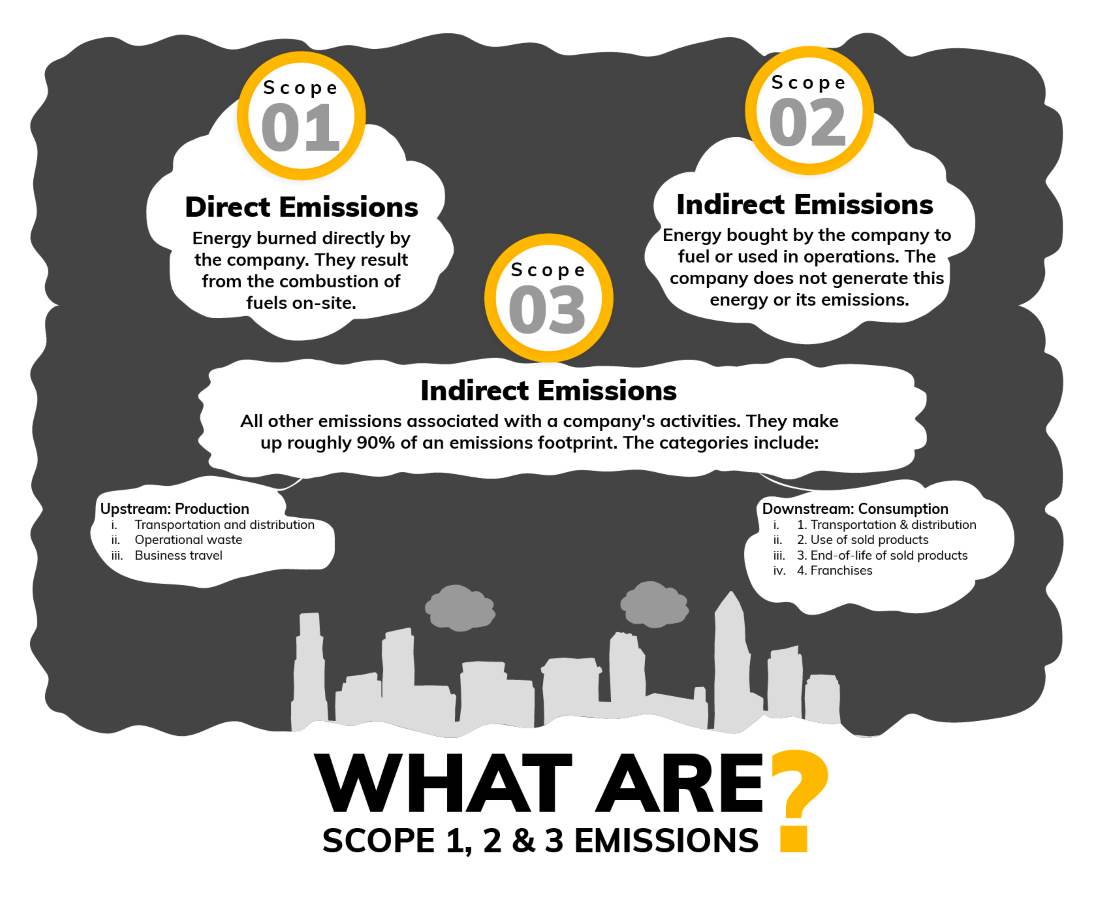7 Crore+ Customers

Affordable Premium

7 Crore+ Customers

Affordable Premium


Carbon emissions in the atmosphere pose serious risks not just to the health, but the very existence of populations across Earth. These carbon emissions are part of the greenhouse gases that, when released into the atmosphere, cause global warming and climate change effects.
The major contributors of carbon emissions are big organizations, industries and companies. Hence, it is important to regulate and reduce their carbon emissions. Besides, a company must then take steps to record and measure their emissions from all sources.
Finally, they are required to implement strategies to reduce and eliminate carbon emissions. This will be a step towards becoming carbon neutral or achieving net-zero.
To be able to measure carbon emissions, it is important to understand its different categories. In this article we will learn about the different categories or "scopes" of emissions with some examples.

Based on their sources, greenhouse gases are divided into three different scopes.
In 2001, the Greenhouse Gas Protocol (GHGP) was established by the World Resources Institute (WRI) and the World Business Council for Sustainable Development (WBCSD) to simplify emissions tracking and assist businesses in finding ways to decrease their emissions.
The GHGP divides all emissions into three scopes. While reporting emissions from scope 1 and 2 is mandatory for many countries and organizations, measuring scope 3 emissions is often optional.
Alyssa Rade, the chief sustainability officer at Sustain.Life simplifies these 3 scopes: "Burn, Buy, Beyond. Scope 1 is what you burn; scope 2 is the energy you buy; and scope 3 is everything beyond that."
Let's take a cloth manufacturer for example. The scope 1 emissions include the direct emissions from the factory such as fuel used to power their equipment, emission from company vehicles, etc. Whatever energy is burned directly by the company falls under Scope 1 emissions.
Direct emissions from sources owned or controlled by a reporting company are Scope 1 Emissions. They result from the combustion of fuels on-site.
Scope 1 Emissions include:
Some examples of scope 1 emissions are businesses with a physical footprint:
Equipment or assets that support any organizations, but that are not owned or controlled by that organisation, doesn’t fall under scope 1 emissions.
Since organizations have direct control of emissions created on-site, scope 1 emissions are typically the easiest to manage and mitigate.
Scope 2 emissions are indirect emissions generated from purchased energy, including:
Some examples of Scope 2 Emissions include energy that is consumed or emitted from rented or leased:
Finally, the cloth manufacturer measures his scope 3 emissions by considering the energy required to grow the material, process cotton fibres, transit miles taken to deliver the raw materials, energy used by consumers to wash and dry the clothing and the GHG emissions generated as the materials decay in a landfill, etc.
Scope 3 emissions are all the other emissions associated with a company's activities. It is important for companies and organizations to take scope 3 emissions into account as they make up roughly 90% of an emissions footprint.
There are 15 categories of upstream and downstream activities throughout the value chain that make up scope 3 emissions:
Upstream: In Production of a Product
Downstream: In Consumption of a Product
You can manage only what you can measure. Now that you are aware of the different categories of emissions, you are a step closer to managing and reducing your organizations carbon emissions.
By individually calculating each scope's total emissions, you can accurately report the progress of your company targeting to reduce its GHG emissions.
The World Resources Institute (WRI) and the World Business Council for Sustainable Development (WBCSD) developed The Greenhouse Gas Protocol in 1998 as a standard for measuring and reporting emissions.
It is the most widely used international protocol adopted by governments, industry associations, nonprofit agencies and corporations. Brazil, India, Mexico and the Philippines all employ GHG Protocol-based systems to collect valuable emissions data.
Identifying scope emissions can also help you understand which section needs to be focused on to make it more carbon efficient.
Scope 1 and 2 emissions are mandatory to report, while scope 3 emissions are voluntary and the most difficult to monitor. However, scope 3 emissions are what make up most of a company's carbon footprint.
Hence, if an organization wants to truly become carbon neutral or achieve net zero, they will have to pay attention and include scope 3 emissions in their carbon accounting strategy.
While GHG or carbon accounting might seem daunting, it should be the first step in a company's sustainable development journey.
There are many platforms that help organizations in this field. Organizations can focus on efficient opportunities, waste reduction opportunities or ways to streamline procurement or other essential activities.
Measuring scope emissions can help organizations:
Controlling scope emissions is no easy feat. Companies need to look at what operations emit most carbon and which take most energy. Efficiency is key in streamlining any business process.
To reduce scope emissions, organizations can:
Accurately scope emissions will only help better organizations and brand in the public favour. Although it might seem like a tedious process, it is an important step towards sustenance and growth.